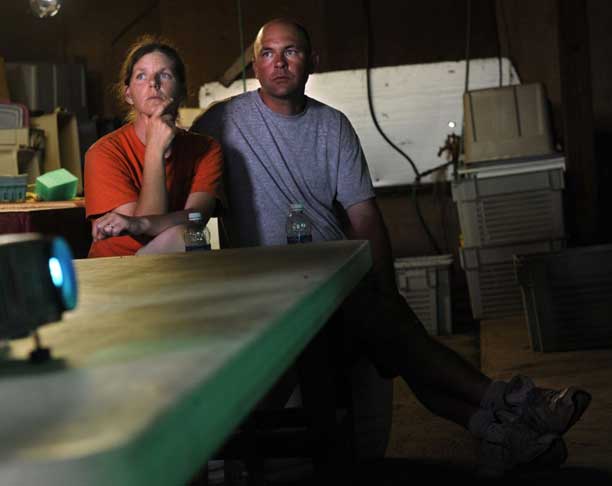Brian Poeppel, left, his wife Anita, right, and farmer Jane Heim, second from left, listen as Karl Tupper gives instructions for a device to measure chemical drift. At far right, are the Peoppel’s children, Laura, 3, and Lucy, 9. /Photo by David Zalaznick
By Clare Howard
Brian and Anita Poeppel were brimming with excitement when they left their farm just outside Chicago and moved to 15 acres they planned to farm organically in Central Illinois. Trouble started before the first harvest. It was invisible, sometimes drifting into the big old farmhouse on a summer breeze, sometimes blanketing the children’s backyard swing set, always teasing with its anonymity and guile.
The Poeppels had known from the beginning theirs would be an organic farm surrounded by a sea of farms using chemical fertilizers and pesticides. To the young couple, it had at first seemed reasonable that organic farmers and chemical farmers could coexist. The Poeppels visited their new neighbors and talked about their hopes and dreams of a healthy life.
For six years, the couple struggled when pesticides sprayed on nearby farms drifted over their property. Their daughters stayed indoors gazing out at their swing set, wading pool and favorite climbing trees. Once, Brian Poeppel, 40, was arrested for trespass. He had tried to block a chemical applicator working on a nearby field, saying the pesticides were blowing directly onto the Poeppel’s property. He was convicted of disorderly conduct, fined $500 and put on probation for two years.
Then the Poeppels changed their strategy. They stopped pleading with neighbors, and started filing complaints with the Illinois Department of Agriculture. They organized a statewide network of farmers to investigate pesticide drift. The Poeppels signed up for the Drift Catcher program conducted by the Pesticide Action Network, a not-for-profit group. Organic farmers 2,000 miles west of them organized a movement they are calling the Pitchfork Rebellion, and turned to independent urinalysis testing.
Their independent analysis is producing a startling picture of the tendency of pesticides sprayed in one area to migrate on the air and in water supplies. Along with new research on the potential health effects of these chemicals, these analyses are prompting a new vision of chemical drift as a form of trespass, willful negligence and property damage.
“The system is phenomenally productive with huge yields, small amounts of work and little fossil fuel input,” said Dave Kennell, associate director of the Center for Renewable Energy at Illinois State University. “But now we know about the dead zones (in oceans), human health effects, death of the soil, erosion and resistant pathogens and weeds.
We can’t discount that when we look at the big picture,” Kennell said.
A French court issued a historic verdict finding biotech giant Monsanto guilty of pesticide poisoning of a 47-year-old French grain farmer who suffered neurological damage including memory loss, headaches and stammering after a 2004 incident when he inhaled the herbicide Lasso, a product banned in the European Union in 2007 but still registered and used in the United States.
In a statement, the company said it had complied with safety and marketing guidelines in force at the time, and that it plans to appeal.

Gathering evidence
On a Sunday in July, already hot and humid by mid-morning, two other organic farm families joined the Poeppels for a training session to learn how to install and operate Drift Catcher monitoring equipment. Karl Tupper, then a scientist with PAN, flew from California to conduct the training. Organic farmers Greg and Janet Morse rumbled into the barnyard on their 1980 Honda motorcycle. Jane Heim drove down from her farm near Paw Paw, Ill.
Training started in the barn with a PowerPoint presentation projected onto a white sheet hung from the rafters. In other regions of the country, Tupper told the group, evidence gathered through Drift Catchers helped shape public policy. He explained that spray drift in the form of droplets or dust that moves off the targeted site is regulated, but that drift that has volatilized, or turned to vapor, is unregulated by the EPA and by state agencies. Drift Catcher monitoring equipment detects both types.
Laboratory analysis of results from each farm can cost more than $6,000.
“This country has built an agricultural economy around toxins,” Tupper said. “These pesticides are in our bodies. Drift is inevitable. But the chemical industry wants to say drift is okay as long as it is below some safe amount.
“How do you define that safe amount, especially when a profit is made fm these chemicals, but the cost of drift falls on the victim?” Tupper asked.
The Morses have farmed 365 acres without chemicals for 23 years in the Crow Creek valley near Putnam, Ill., and say they have fought all that time against chemical drift. In 1999, they said, spray drift damage covered their entire farm. But the source was not clear. The couple worries that after years of effort and expense to earn the U.S. Certified Organic designation for their farm, they could lose their status because of drift.
Greg Morse and his wife continue to file complaints even though little is done. They said they face regular retaliation, insisting that spray planes working on nearby farms often buzz their house. They took extra precautions when their children were growing up. They feared their son, a long-distance track runner who often ran through their timberland, would be deliberately sprayed as retaliation for his parents’ complaints.
“One time, I just went berserk when a plane buzzed our house and turned on the sprayer over our farm,” said Morse, 64. “I took a shotgun and play acted. There was no shell in the gun. A Putnam County sheriff came out to the farm and said he’d heard I was shooting at crop planes. But we’re in Bureau County, so within three hours a Bureau County Sheriff shows up.”

Asked about the incident, Bureau County Sheriff John Thompson said his deputy responded to a complaint filed by the plane pilot, a transient crop duster.
But Sheriff Thompson added that pesticide drift is a common problem. He rides his motorcycle to work and has been sprayed by a crop duster.
“I have no idea what the chemicals were,” he said.
The Morses point to the irony of this. When they file drift complaints with the Illinois Department of Agriculture, it can be weeks before an inspector shows up to investigate and take samples for chemical residue. One time, Greg Morse was standing in his pasture with his organic cows and felt the chemical spray dousing him.
“I can’t afford to have a camera crew filming these guys. It shouldn’t be up to us to monitor all the time. Why should we have to regulate and defend?” he asked.
Tupper, of the Pesticide Action Network, is sympathetic but said, “The onus falls on the victim.”
“Not only are we the victims,” Brian Poeppel said, “but we’re the bad guys in the community just because we don’t want to be drifted on.”
Chemical manufacturers contend their products pose no hazards. In a statement late Tuesday, Syngenta, which manufactures the weed-killer atrazine, dismissed concerns about its safety. Some 76 million pounds of atrazine are applied over American soil each year, much of it aerially.
The company called atrazine “one of the most carefully examined herbicides in the world,” adding, “Its safety has been clearly established by more than 6,000 scientific studies conducted over the past 50 years.”
Under the U.S. Farm Bill, the government subsidizes farmers of chemically-treated commodity crops including corn, cotton, soybeans and wheat. There is no subsidy program for organic produce.
“It looks like the government is on the chemical industry’s side,” said Janet Morse, 62.
People get discouraged from filing complaints because the government does not enforce regulations, Anita Poeppel said.
“Campaign to get people to report drift,” Tupper said. “When complaints are not filed, agencies say there is no problem. Slowly but surely things are changing. Buffer zones and no-spray zones are being established.”
After lunch under the backyard maple trees, the group unpacked and assembled the monitoring equipment. Everyone had a hand at putting together the equipment and reviewing recording procedures. It was a long, humid day with little levity save that provided by Bella, the Poeppel’s Anatolian shepherd, who liked to be either in the thick of things or running through the children’s wading pool.
Everyone passed certification in the Drift Catcher program. By late afternoon, Janet Morse stood alone, staring at the assembled equipment.
“I’ve been waiting for this for 23 years,” she said quietly, almost to herself.

The results
Results came back five months later, just days before Thanksgiving. The Poeppel and Morse farms were getting chlorpyrifos drift, an insecticide considered highly toxic to bees, wildlife and humans even at low levels. It is used widely on corn. The EPA banned all uses in homes and daycare centers because of its toxicity for children, but still allows its agricultural uses. Chlorpyrifos is linked to ADHD and autism, is considered hazardous to brain development and impacts neurobehavioral development in fetuses and children. In utero exposure at even minor levels is linked with pervasive developmental disorders.
The highest concentration of chlorpyrifos detected was at the Poeppel farm. The Drift Catcher log at the time of the sampling included a notation that pesticides were being applied by plane several miles to the northwest.
Dr. Susan Kegley, a scientist who founded the Pesticide Research Institute in 2006 to provide research and consulting on the chemistry of pesticides, considers this alarming for several reasons. The distance between the Poeppel farm and the aerial application was about two miles or more, yet drift was still detected. The level was about half the EPA recommended exposure limit for a 1-year-old child; however, because the reading was an average over a 20-hour period, there could have been dangerous spikes. She believes neurological harm can be occurring at levels lower than what the EPA considers safe.
“This is a pesticide that should be taken off the market. We can’t afford to have more children with ADHD and developmental problems,” she said. “The EPA has not included inhalation of chlorpyrifos in its risk assessment, believing it’s not significant. We found inhalation is a huge risk for people living near an application.”
For the Poeppels, the level of chlorpyrifos confirms their suspicions, but reopens the question of whether to stay or sell the farm and try to start somewhere else.
“We’re getting blasted. We’re right in the middle of this and we fear for our girls — raising them in this area,” Anita Poeppel said. “Whenever we ask someone about what is being aerially applied, they say, ‘Don’t worry, it’s just fungicide.'”
Now they are striking at the pocketbooks of neighbors who use aerial spraying, by filing claims to their insurance companies. Their first claim is being processed. An inspector came to the farm and confirmed what the Poeppels knew: the organic apple crop had been damaged by chemical drift.
Clare Howard is a freelance journalist and member of 100Reporters. This article was made possible with a George Polk Investigative Reporting grant funded by the Ford Foundation.









[…] https://100r.org/2012/02/pitchfork-rebels-organic-farmers-take-on-big-agriculture/ […]
Excellent article and the most efficient way to document pesticide “drift” and potentially GMO pollen drift problem as Chapela did with Mexican corn.
This past May, 2011, agricultural drift hit my1.5 acre organic orchard, garden and ornamental plants from an adjacent field. I thought the excessive spraying was intentional due to my complaints of the same farmer using our community’s residential streets with loaded grain trucks that tear up the pavement and disrupt our peace. The Indiana state chemist came to my property about two weeks after the drift (because he is so busy with other drift complaints) and finally determined (Jan. 2012) pinpointed the source; the adjacent field as I suspected all along. Now its in the process of settlement with the farmer’s insurance company. I will see what kind of settlement is offered by the insurance company, but I am assuming they will fight for every penny. Keep posted.Â
great article monsano released a new product a remake of agent orange! also monsanto knew for years that roundup caused birth defects!, monsanto should be sued by every human on earth! good idea a 4 billion person class action suit would be effective and to fire everyone in epa, agriculture dept, etc they simply have brain washed while killing you slowly sometimes quickly, I myself in ignorance used chemicals stupid! companion planting is the answer, I leave some weeds the bugs actually prefer them over the main events! I also plant milkweed a companion crop to corn that God designed that way so the Monarch butterfly would come and join in the joys of pollination! wake up save yourselves and your planet be part of the solution!